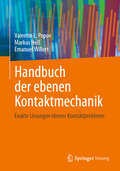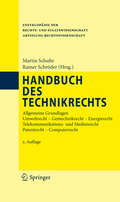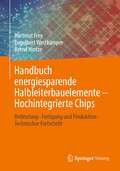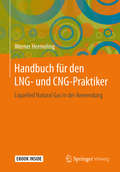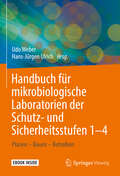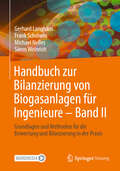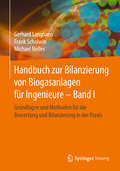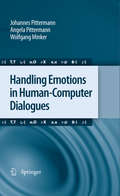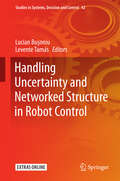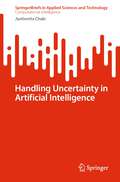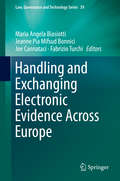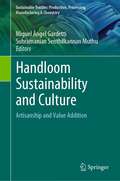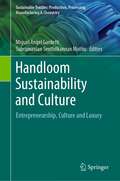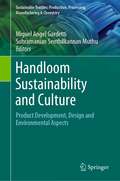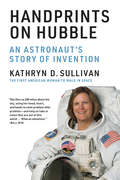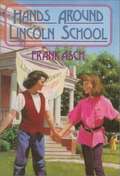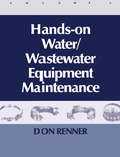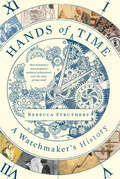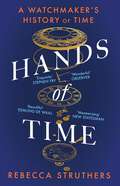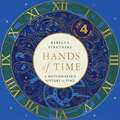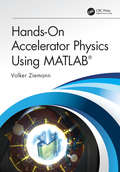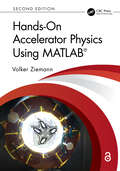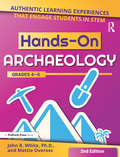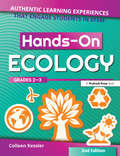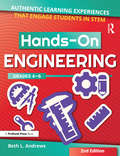- Table View
- List View
Handbuch der ebenen Kontaktmechanik: Exakte Lösungen ebener Kontaktprobleme
by Valentin L. Popov Markus Heß Emanuel WillertDas Buch beinhaltet eine strukturierte Sammlung der vollständigen Lösungen aller wesentlichen ebenen Kontaktprobleme. Es werden klassische Profile – wie der Zylinder, der Keil oder der quaderförmige flache Stempel – unter zentrischer und exzentrischer Belastung behandelt, aber auch eine Vielzahl weiterer technisch relevanter Formen, wie der flache Stempel mit abgerundeten Kanten, der Keil mit abgerundeter Spitze oder wellige Oberflächen. In Bezug auf die Lastkonfiguration werden adhäsive und adhäsionsfreie Normalkontakte, Tangentialkontakte und Rollkontakte berücksichtigt. Als Materialien kommen elastisch isotrope, transversal isotrope, viskoelastische und funktionale Gradientenmedien zur Sprache. Die angegebenen Lösungen werden jeweils auf dem einfachsten zur Verfügung stehenden Weg hergeleitet und umfassen neben den makroskopischen Zusammenhängen zwischen der Last und der Kontaktkonfiguration die Spannungsfelder in der Oberfläche und gegebenenfalls innerhalb der Kontaktkörper.
Handbuch des Technikrechts
by Martin Schulte Rainer SchröderDas Handbuch wendet sich an alle in Wissenschaft und Praxis mit dem Technikrecht befassten Juristen, die sich einen ersten vertieften Einblick in dieses neue Rechtsgebiet verschaffen wollen. Die Grundlagen des Technikrechts werden dargestellt; einzelne, besonders wichtige Bereiche des Technikrechts werden eingehend analysiert.
Handbuch energiesparende Halbleiterbauelemente – Hochintegrierte Chips: Bedeutung · Fertigung und Produktion · Technischer Fortschritt
by Engelbert Westkämper Hartmut Frey Bernd HintzeDurch die Fähigkeit, nahezu jedes Gerät oder Produkt mit Sensoren oder Funketiketten zu verbinden, können Unternehmen intelligente Netzwerke betreiben. Daneben darf die Bedeutung der klassischen Märkte für die Möglichkeit der Umsetzung – wie schnelle Server, energiesparende Clouds usw. – nicht übersehen werden. Fast ein Fünftel des gesamten digitalen Energieverbrauchs benötigen Rechenzentren, genauso viel wie alle internetfähigen Geräte selbst. Höchstintegrierte, schnelle und energiesparende Chips werden zur Schlüsseltechnologie insbesondere für den Zukunftsmarkt Smart Mobility. Dieses Buch gibt einen umfassenden Überblick über die Möglichkeiten, Eigenschaften und Fertigungstechnologien solcher Halbleiterbauelemente.
Handbuch für den LNG- und CNG-Praktiker: Liquefied Natural Gas in der Anwendung
by Werner HermelingDie wichtigsten physikalischen Grundlagen sowie die ingenieurtechnische Ausstattung (Bauteile, Baugruppen sowie deren Funktion) für die Regasifizierung und Kompressison tiefkalt verflüssigter Gase (inkl. Biogas / Methan aus rezenten Quellen) sind in diesem Buch dargestellt. Es werden Praxishinweise zur möglichen Anlagenauslegung und -gestaltung gegeben. Auf sicherheitstechnische sowie produktspezifische Ausführungen wird hingewiesen und deren Lösungen sind beschrieben. Das Buch enthält hierzu zahlreiche Hinweise und Zusammenfassungen. Der Autor ist Ingenieur des chemischen Anlagenbaus sowie der Wärme-, Lüftungs- und Klimatechnik mit langjähriger praktischer Erfahrung im Bereich der tiefkalt verflüssigten Gase, deren Transport, Regasifizierung und Kompression. Er ist Erfinder mehrerer patentierter und realisierter Lösungen. Dieses Buch wendet sich an Sicherheitsbeauftragte, Anlagenbetreiber, Mitarbeiter im direkten Umgang mit solchen Anlagen sowie Entscheidungsträger und Genehmigende Behörden.
Handbuch für mikrobiologische Laboratorien der Schutz- und Sicherheitsstufen 1–4: Planen – Bauen – Betreiben
by Steffen Schmidt Thomas Koch Klaus Söhngen Ronny Conrad Harald Gehring Thomas Hinrichs Sven Krage Jürgen Mertsching Josef Ortner Rainer Post Detlef Reichenbacher Torsten WernerDieses Handbuch ist für all diejenigen gedacht, die sich mit der Thematik der biologischen Sicherheit beschäftigen müssen oder wollen. Es soll ein Leitfaden für richtige Entscheidungen zur Umsetzung der rechtlichen Forderungen des Gesetzgebers sein. Hierzu gehört insbesondere das Gentechnikgesetz und die Gentechniksicherheitsverordnung, das Infektionsschutzgesetz, die Biostoffverordnung und dazugehörige TRBA sowie Beschlüsse des Ausschusses für biologische Arbeitsstoffe (ABAS). Die Mehrzahl von Biostoffen, mit denen in mikrobiologischen und gentechnischen Laboratorien gearbeitet wird, stellen für das Personal, eventuell für Nichtbeteiligte und für die Umwelt, Gefahrenquellen dar. Viele dieser Biostoffe können pathogen sein. Daher ist der Umgang nur unter besonderen Schutzvorkehrungen zulässig. Eine Reihe von Gesetzen und Verordnungen, wie das Gentechnikgesetz und die Biostoffverordnung, regeln den Umgang mit Biostoffen. Die beschriebenen Schutzvorkehrungen basieren auf unterschiedlichen rechtlichen Verordnungen. Es werden die Beschaffenheit und die Anforderungen an Schutz- und Sicherheitsstufen in Laboratorien 1–4, in denen Tätigkeiten mit Biostoffen bzw. gentechnische Arbeiten durchgeführt werden, beschrieben. Die aufgeführten Hinweise und Beispiele entsprechen dem Stand der Wissenschaft und Technik und zeigen Lösungswege auf, die sich bei der Umsetzung der Schutz- und Sicherheitsmaßnahmen in der Praxis bewährt haben.
Handbuch zur Bilanzierung von Biogasanlagen für Ingenieure - Band II: Grundlagen und Methoden für die Bewertung und Bilanzierung in der Praxis
by Gerhard Langhans Frank Scholwin Michael Nelles Sören WeinrichAus dem breiten Anwendungsfeld für Biogasgewinnung ergeben sich mannigfaltige Anforderungen, die den Praktiker oft vor spezielle Herausforderungen stellen. Hier setzt das Buch an und konzentriert sich auf die in der Praxis relevanten technischen Herausforderungen der Technologie und bereitet die wissenschaftlichen Grundlagen der anaeroben Prozessführung für Herausforderungen in der Praxis auf (Anwendbarkeit, Interpretation der Messgrößen, Zuverlässigkeit von Bewertungsmethoden) und stellt zur schnellen Abschätzung u. a. Nomogramme und Parametersammlungen zur Verfügung.
Handbuch zur Bilanzierung von Biogasanlagen für Ingenieure – Band I: Grundlagen und Methoden für die Bewertung und Bilanzierung in der Praxis
by Gerhard Langhans Frank Scholwin Michael NellesAus dem breiten Anwendungsfeld für Biogasgewinnung ergeben sich mannigfaltige Anforderungen, die den Praktiker oft vor spezielle Herausforderungen stellen. Hier setzt das Buch an und konzentriert sich auf die in der Praxis relevanten technischen Herausforderungen der Technologie und bereitet die wissenschaftlichen Grundlagen der anaeroben Prozessführung für Herausforderungen in der Praxis auf (Anwendbarkeit, Interpretation der Messgrößen, Zuverlässigkeit von Bewertungsmethoden) und stellt zur schnellen Abschätzung u. a. Nomogramme und Parametersammlungen zur Verfügung.
Handling Emotions in Human-Computer Dialogues
by Wolfgang Minker Johannes Pittermann Angela PittermannIn this book, a novel approach that combines speech-based emotion recognition with adaptive human-computer dialogue modeling is described. With the robust recognition of emotions from speech signals as their goal, the authors analyze the effectiveness of using a plain emotion recognizer, a speech-emotion recognizer combining speech and emotion recognition, and multiple speech-emotion recognizers at the same time. The semi-stochastic dialogue model employed relates user emotion management to the corresponding dialogue interaction history and allows the device to adapt itself to the context, including altering the stylistic realization of its speech. This comprehensive volume begins by introducing spoken language dialogue systems and providing an overview of human emotions, theories, categorization and emotional speech. It moves on to cover the adaptive semi-stochastic dialogue model and the basic concepts of speech-emotion recognition. Finally, the authors show how speech-emotion recognizers can be optimized, and how an adaptive dialogue manager can be implemented. The book, with its novel methods to perform robust speech-based emotion recognition at low complexity, will be of interest to a variety of readers involved in human-computer interaction.
Handling Uncertainty and Networked Structure in Robot Control
by Lucian Buşoniu Levente TamásThisbook focuses on two challenges posed in robot control by the increasingadoption of robots in the everyday human environment: uncertainty and networkedcommunication. PartI of the book describes learning control to address environmental uncertainty. Part II discusses state estimation, active sensing, and complex scenarioperception to tackle sensing uncertainty. Part IIIcompletes the book with control of networked robots and multi-robot teams. Each chapter features in-depth technical coverage and case studieshighlighting the applicability of the techniques, with real robots or insimulation. Platforms include mobile ground, aerial, and underwater robots, aswell as humanoid robots and robot arms. Source code and experimental data areavailable at http://extras. springer. com. The text gathers contributions from academic and industry experts,and offers a valuable resource for researchers or graduate students in robotcontrol and perception. It also benefits researchers in related areas, such ascomputer vision, nonlinear and learning control, and multi-agent systems.
Handling Uncertainty in Artificial Intelligence (SpringerBriefs in Applied Sciences and Technology)
by Jyotismita ChakiThis book demonstrates different methods (as well as real-life examples) of handling uncertainty like probability and Bayesian theory, Dempster-Shafer theory, certainty factor and evidential reasoning, fuzzy logic-based approach, utility theory and expected utility theory. At the end, highlights will be on the use of these methods which can help to make decisions under uncertain situations. This book assists scholars and students who might like to learn about this area as well as others who may have begun without a formal presentation. The book is comprehensive, but it prohibits unnecessary mathematics.
Handling and Exchanging Electronic Evidence Across Europe (Law, Governance and Technology Series #39)
by Maria Angela Biasiotti Jeanne Pia Mifsud Bonnici Joe Cannataci Fabrizio TurchiThis volume offers a general overview on the handling and regulating electronic evidence in Europe, presenting a standard for the exchange process. Chapters explore the nature of electronic evidence and readers will learn of the challenges involved in upholding the necessary standards and maintaining the integrity of information. Challenges particularly occur when European Union member states collaborate and evidence is exchanged, as may be the case when solving a cybercrime. One such challenge is that the variety of possible evidences is so wide that potentially anything may become the evidence of a crime. Moreover, the introduction and the extensive use of information and communications technology (ICT) has generated new forms of crimes or new ways of perpetrating them, as well as a new type of evidence. Contributing authors examine the legal framework in place in various EU member states when dealing with electronic evidence, with prominence given to data protection and privacy issues. Readers may learn about the state of the art tools and standards utilized for treating and exchanging evidence, and existing platforms and environments run by different Law Enforcement Agencies (LEAs) at local and central level. Readers will also discover the operational point of view of LEAs when dealing with electronic evidence, and their requirements and expectations for the future. Finally, readers may consider a proposal for realizing a unique legal framework for governing in a uniform and aligned way the treatment and cross border exchange of electronic evidence in Europe. The use, collection and exchange of electronic evidence in the European Union context and the rules, practises, operational guidelines, standards and tools utilized by LEAs, judges, Public prosecutors and other relevant stakeholders are all covered in this comprehensive work. It will appeal to researchers in both law and computer science, as well as those with an interest in privacy, digital forensics, electronic evidence, legal frameworks and law enforcement.
Handloom Sustainability and Culture: Artisanship and Value Addition (Sustainable Textiles: Production, Processing, Manufacturing & Chemistry)
by Subramanian Senthilkannan Muthu Miguel Ángel GardettiThis book contains seven chapters written by leading experts in the areas and discusses means to revive some of the cultures that are on the verge of closing/shutting down. This second of the three book series highlights the intricate relationship in the handloom industry between its culture and the various areas of sustainability. While there have been major disruptions in this age old industry, this book presents the craftsmanship/artisanship and its value addition to keep the industry moving ahead.
Handloom Sustainability and Culture: Entrepreneurship, Culture and Luxury (Sustainable Textiles: Production, Processing, Manufacturing & Chemistry)
by Subramanian Senthilkannan Muthu Miguel Ángel GardettiThis first of the three volume series highlights the intricate relationship in the handloom industry between its culture and the various areas of sustainability. While there have been major disruptions in this age old industry, this volume presents the luxury and the entrepreneurship aspects to keep the industry moving ahead. The book contains seventeen chapters written by leading experts in the areas and discusses means to revive some of the cultures that are on the verge of closing/shutting down.
Handloom Sustainability and Culture: Product Development, Design and Environmental Aspects (Sustainable Textiles: Production, Processing, Manufacturing & Chemistry)
by Subramanian Senthilkannan Muthu Miguel Ángel GardettiThis third of the three volume series highlights the intricate relationship in the handloom industry between its culture and the various areas of sustainability. While there have been major disruptions in this age old industry, this volume presents the design, development and environmental aspects to keep the industry moving ahead. The book contains seven chapters written by leading experts in the areas and discusses means to revive some of the cultures that are on the verge of closing/shutting down.
Handprints on Hubble: An Astronaut's Story of Invention (Lemelson Center Studies in Invention and Innovation series)
by Kathryn D. SullivanThe first American woman to walk in space recounts her experience as part of the team that launched, rescued, repaired, and maintained the Hubble Space Telescope. <p><p> The Hubble Space Telescope has revolutionized our understanding of the universe. It has, among many other achievements, revealed thousands of galaxies in what seemed to be empty patches of sky; transformed our knowledge of black holes; found dwarf planets with moons orbiting other stars; and measured precisely how fast the universe is expanding. In Handprints on Hubble, retired astronaut Kathryn Sullivan describes her work on the NASA team that made all of this possible. Sullivan, the first American woman to walk in space, recounts how she and other astronauts, engineers, and scientists launched, rescued, repaired, and maintained Hubble, the most productive observatory ever built. <p><p> Along the way, Sullivan chronicles her early life as a “Sputnik Baby,” her path to NASA through oceanography, and her initiation into the space program as one of “thirty-five new guys.” (She was also one of the first six women to join NASA's storied astronaut corps.) She describes in vivid detail what liftoff feels like inside a spacecraft (it's like “being in an earthquake and a fighter jet at the same time”), shows us the view from a spacewalk, and recounts the temporary grounding of the shuttle program after the Challenger disaster. <p><p>Sullivan explains that “maintainability” was designed into Hubble, and she describes the work of inventing the tools and processes that made on-orbit maintenance possible. Because in-flight repair and upgrade was part of the plan, NASA was able to fix a serious defect in Hubble's mirrors—leaving literal and metaphorical “handprints on Hubble.” <p><p> Handprints on Hubble was published with the support of the MIT Press Fund for Diverse Voices.
Hands Around Lincoln School
by Frank AschAmy, a shy sixth grader, is frequently caught up in the escapades of her mercurial best friend, so when Lindsay decides to form a Save the Earth Club at school, Amy goes along with the plan. They enlist the participation of the '60s-obsessed twins, Ruth and Heather, and find a teacher to be their advisor. They meet moderate success with a project to hold classroom discussions on Sadako and the Thousand Paper Cranes, and ultimately triumph when their skit, a mock TV-talk show demonstrating the negative effects of war toys and violent video games, wins the school talent contest. Things begin to unravel when Lindsay is suspended for supposedly spray painting the school's front door; she quits the club and disappears. All is resolved as the students join hands around the school to celebrate Earth Day. While there is a lot happening here to both interest and involve readers, some of the situations and dialogue do not ring true. Ms. Peterson's insistence that the club limit its membership to the four girls, and TV coverage of the school's Earth Day event when a student has ostensibly disappeared the previous day are hard to believe. Amy's brother, who calls himself The Avenger, is truly a mean-spirited child, and Lindsay's serious emotional problems are glossed over. Readers will, however, recognize the power of peer pressure, the need to belong, the beginnings of romance, and the importance of Amy's ability to overcome her shyness and defend her rights.
Hands On Water and Wastewater Equipment Maintenance, Volume II
by Barbara RennerHands-On Water/Wastewater Equipment Maintenance, Volumes 1 and 2 deals with equipment maintenance as individual components, not as complete machines, allowing more information about the design, application and maintenance requirements of machinery to be presented. This work-related inventory of wastewater covers plant components where breakdowns most frequently occur. The text explains the design, operation and maintenance of equipment critical to plant functioning; motors, pumps, blowers, mixers and more. The author demonstrates how careful attention to specific equipment parts and operation, especially through systematic maintenance, will lead to fewer breakdowns and more rapid repairs. These texts cover basic operating characteristics of machinery components, making them a valuable reference source as well as a training and maintenance manual.Written in easy-to-understand language, without complex formulas or technical theories, Hands-On Water/Wastewater Equipment Maintenance Volumes 1 and 2 provides you with basic information to help you acquire a general understanding of how components function and how to keep equipment operating properly. These two volumes belong in every water and wastewater treatment plant as a reference and manual for equipment maintenance. The hands-on approach provides maintenance operators, crew leaders and supervisors with practical information about how the machinery they work with every day functions, and how to keep it running smoothly.
Hands of Time: A Watchmaker's History
by Rebecca Struthers"Forty-thousand years of our relationship with time condensed into 288 pages: a hugely entertaining achievement." –Esquire"As impeccably crafted and precisely engineered as any of the watches on which the author has worked so lovingly over the years, this book is a joy to behold and a wonder to enjoy.” –Simon Winchester, author of The Perfectionists and LandAn award-winning watchmaker—one of the few practicing the art in the world today—chronicles the invention of time through the centuries-long story of one of mankind’s most profound technological achievements: the watch.Timepieces have long accompanied us on our travels, from the depths of the oceans to the summit of Everest, the ice of the arctic to the sands of the deserts, outer space to the surface of the moon. The watch has sculpted the social and economic development of modern society; it is an object that, when disassembled, can give us new insights both into the motivations of inventors and craftsmen of the past, and, into the lives of the people who treasured them.Hands of Time is a journey through watchmaking history, from the earliest attempts at time-keeping, to the breakthrough in engineering that gave us the first watch, to today – where the timepieces hold cultural and historical significance beyond what its first creators could have imagined. Acclaimed watchmaker Rebecca Struthers uses the most important watches throughout history to explore their attendant paradigm shifts in how we think about time, indeed how we think about our own humanity. From an up-close look at the birth of the fakes and forgeries industry which marked the watch as a valuable commodity, to the watches that helped us navigate trade expeditions, she reveals how these instruments have shaped how we build and then consequently make our way through the world.A fusion of art and science, history and social commentary, this fascinating work, told in Struthers’s lively voice and illustrated with custom line drawings by her husband and fellow watchmaker Craig, is filled with her personal observations as an expert watchmaker—one of the few remaining at work in the world today. Horology is a vast subject—the “study of time.” This compelling history offers a fresh take, exploring not only these watches within their time, but the role they played in human development and the impact they had on the people who treasured them.
Hands of Time: A Watchmaker's History of Time
by Rebecca StruthersBBC RADIO 4 BOOK OF THE WEEK: An intricate and personal history of watches and time from an extraordinary watchmaker and historian'An exquisite book, as beautifully put together as one of the watches whose mechanisms Rebecca Struthers describes with such eloquence.' Stephen Fry'5/5 A true joy... a work of staggering complexity and bewildering economy .' Telegraph'A rattling, wonderful, decidedly non-nerdy read.' Observer'Every page glitters' Spectator'Absolutely gorgeous. It blew my socks off' Jay Blades'An intensely personal, finely-tuned meditation... a beautiful book' Edmund de Waal'Beautiful, bewitching and brilliant' Lara MaiklemTimepieces are one of humanity's most ingenious innovations. Their invention was more significant for human culture than the printing press, or even the wheel. They have travelled the world with us, from the depths of the oceans to the summit of Everest, and even to the Moon. They regulate our daily lives and have sculpted the social and economic development of society in surprising and dramatic ways.In Hands of Time watchmaker and historian Rebecca Struthers welcomes us into the hidden world of watchmaking, offering a personal history of watches that spans centuries and continents. From her workshop bench, Rebecca explores the ways in which timekeeping has indelibly shaped our attitudes to work, leisure, trade, politics, exploration and mortality, and introduces us to some extraordinary and treasured devices, each with their own story to tell.Hands of Time is an intricate and uniquely personal exploration of the history, science, philosophy, and craft of timekeeping.
Hands of Time: A Watchmaker's History of Time. 'An exquisite book' - Stephen Fry
by Rebecca StruthersA watchmaker's world is not much bigger than a thumbnail.I spend whole days working on mechanisms which can contain hundreds of tiny components. Each of them has a specific task to perform. Every morning when I sit at my bench, it is an adventure into a new timepiece with its own history to lose myself in. And in their history, we can find the history of time itself.Timepieces are one of humanity's most ingenious innovations. Their invention was more significant for human culture than the printing press, or even the wheel. They have travelled the world with us, from the depths of the oceans to the summit of Everest, and even to the Moon. They regulate our daily lives and have sculpted the social and economic development of society in surprising and dramatic ways.In Hands of Time watchmaker and historian Rebecca Struthers welcomes us into the hidden world of watchmaking, offering a personal history of watches that spans centuries and continents. From her workshop bench, Rebecca explores the ways in which timekeeping has indelibly shaped our attitudes to work, leisure, trade, politics, exploration and mortality, and introduces us to some extraordinary and treasured devices, each with their own story to tell.Hands of Time is an intricate and uniquely personal exploration of the history, science, philosophy, and craft of timekeeping.(P) 2023 Hodder & Stoughton Limited
Hands-On Accelerator Physics Using MATLAB®
by Volker ZiemannHands-On Accelerator Physics Using MATLAB® provides an introduction into the design and operational issues of a wide range of particle accelerators, from ion-implanters to the Large Hadron Collider at CERN. Many aspects from the design of beam optical systems and magnets, to the subsystems for acceleration, beam diagnostics, and vacuum are covered. Beam dynamics topics ranging from the beam-beam interaction to free-electron lasers are discussed. Theoretical concepts and the design of key components are explained with the help of MATLAB® code. Practical topics, such as beam size measurements, magnet construction and measurements, and radio-frequency measurements are explored in student labs without requiring access to an accelerator. <P><P>This unique approach provides a look at what goes on 'under the hood' inside modern accelerators and presents readers with the tools to perform their independent investigations on the computer or in student labs. This book will be of interest to graduate students, postgraduate researchers studying accelerator physics, as well as engineers entering the field. <P><P>Features: <li>Provides insights into both synchrotron light sources and colliders <li>Discusses technical subsystems, including magnets, radio-frequency engineering, instrumentation and diagnostics, correction of imperfections, control, and cryogenics <li>Accompanied by MATLAB® code, including a 3D-modeler to visualize the accelerators, and additional appendices which are available on the CRC Press website
Hands-On Accelerator Physics Using MATLAB®
by Volker ZiemannHands-On Accelerator Physics Using MATLAB®, Second Edition, provides a broad introduction into the physics and the technology of particle accelerators from synchrotron light sources to high-energy colliders. It covers the design of beam optics, magnets, and radio-frequency systems, followed by a discussion of beam instrumentation and correction algorithms. Later chapters deal with the interaction of beams with targets, the emission of synchrotron radiation, and intensity limitations. Chapters discussing running and future accelerators round up the presentation. Theoretical concepts and the design of key components are explained with the help of MATLAB code. Practical topics, such as beam size measurements, magnet construction and measurements, and radio-frequency measurements are explored in student labs that do not require access to an accelerator. This unique approach provides a look at what goes on "under the hood" inside modern accelerators and presents readers with the tools to perform their independent investigations on the computer or in student labs. This book will be of interest to graduate students, post-graduate researchers studying accelerator physics, as well as engineers entering the field.The second edition features a new chapter on future accelerators and several new sections on polarization, neutrino beams, testing of superconducting cavities, and matching in longitudinal phase space, among others.The MATLAB code was updated to be consistent with the recent release of R2024a. All code is available from the book’s GitHub site at https://github.com/volkziem/HandsOnAccelerators2nd.Key features: Provides a broad introduction into physics of particle accelerators from synchrotron light sources to high-energy colliders. Discusses technical subsystems, including magnets, radio-frequency engineering, instrumentation and diagnostics, correction of imperfections, control, vacuum, and cryogenics. Illustrates key concepts with sample code in MATLAB.
Hands-On Archaeology: Authentic Learning Experiences That Engage Students in STEM (Grades 4-5)
by John R. White Mattie OverossHands-On Archaeology immerses students in the world of real-life archaeologists. Through engaging authentic learning experiences, students will discover artifacts from the past and participate in archaeological digs while building STEM skills, as well as making connections to geography, history, art, and English language arts. This book is packed with activities that can easily be conducted in the classroom using everyday materials and includes everything teachers need to help students conduct real-life archaeological digs. From participating in digs in the classroom to conducting digs in the community, students will not just learn about archaeology—they will be archaeologists!Grades 4-5
Hands-On Ecology: Authentic Learning Experiences That Engage Students in STEM (Grades 2-3)
by Colleen KesslerHands-On Ecology immerses students in the world of real-life ecologists. Through engaging authentic learning experiences, students will explore ecological habitats while building STEM skills. This book is packed with activities that can easily be conducted in the classroom using everyday materials and includes everything teachers need to help students to explore the makeup of their world, including the animals, plants, and organisms that inhabit it. From studying their local ecosystem to exploring environmentalism and ways they can contribute to conservationism, students will not just learn about ecology—they will be ecologists!Grades 2-3
Hands-On Engineering: Authentic Learning Experiences That Engage Students in STEM (Grades 4-6)
by Beth L. AndrewsHands-On Engineering immerses students in the world of real-life engineers. Through engaging authentic learning experiences, students will create innovative solutions to relevant and timely design and engineering challenges while building STEM skills. This book is packed with activities that can be easily conducted in the classroom using everyday materials and includes everything teachers need to help students think analytically, assess new situations, and solve hands-on, real-world problems. From engaging in practical problem solving and collaboration to employing imagination and perseverance, students will not just learn about engineering—they will be engineers!Grades 4-6
